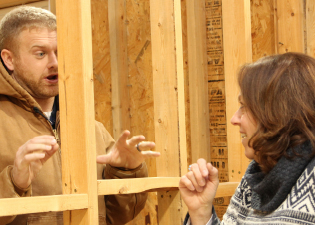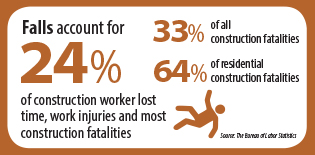Rehabilitation and Participation Science
Program in Occupational Therapy
 Falls from heights are the top cause of construction fatalities and account for one-third of on-the-job injury deaths in the industry.
Falls from heights are the top cause of construction fatalities and account for one-third of on-the-job injury deaths in the industry.
For Vicki Kaskutas, OTD ’08, MHS, OTR/L, FAOTA, improving worker health and safety through the study and prevention of occupational risk factors for injury and illness has been the focus of her research for the past ten years. As a member of the collaboration between the Department of Medicine’s and Program in Occupational Therapy’s Occupational Health and Safety Laboratory, she studies the epidemiology of work-related injuries and illnesses in a broad range of work groups and the interventions needed to prevent and improve overall health in working populations.
The Occupational Safety and Health Administration (OSHA) – the federal agency that provides oversight for health and safety legislation – changed its residential fall protection requirements in 2010. The resulting guidance document published featured pictures, but not the device names or identifying information to help construction professionals find the device. Knowing quick access to the missing information could prevent injury and potentially save lives, Kaskutas applied for and received a grant from the Center for Construction Research and Training through the National Institute of Occupational Safety to develop a website to provide the information.
Launched in October 2014, the Fall Protection Resource for New Home Construction website (ot.wustl.edu/fptech/homepage.htm) demonstrates 148 fall prevention devices. It includes conventional methods of fall protection such as guardrails, personal fall arrest systems and safety nets, as well as other equipment including scaffolds, lifts, hole covers and ladder accessories that can improve safety when working at heights. The website build team included Nina Smock, Stephanie Wise, OTD/S ’15, and Educational Technology Coordinator Ping Lieser, PhD, who was instrumental in the programming and design. The website, the result of 12 months of research and collaborations with 26 manufacturers across the country, was quickly disseminated electronically through many federal governmental agencies, trade organizations, and unions.
“The agencies that funded the project, the Center for Construction Research and Training (CPWR), and the National Institute of Occupational Safety and Health (NIOSH), posted the link to its websites. Jim Maddux, OSHA’s Directorate of Construction, included the link in its bi-monthly newsletter, QuickTakes,” Kaskutas says. “He also sent it to every OSHA education center, field office, and employee with a role in construction. In addition, he helped us to reach several trade organizations, including the Associated Builders and Contractors, Association of General Contractors, and the American Society of Safety Engineers. The St. Louis Carpenters’ Union published an article about the website in their quarterly magazine, which is sent to 27,000 members in Kansas, Mo., and southeastern Illinois.”
 In the first three months, the Fall Protection website had more than 22,500 unique page views. Kaskutas also developed a survey for site visitors to complete to help measure effectiveness
In the first three months, the Fall Protection website had more than 22,500 unique page views. Kaskutas also developed a survey for site visitors to complete to help measure effectiveness
and plan for future updates. “We are seeking additional funding to keep the website up-to-date and sustain long-term operation. New devices are being developed every day—vendor links need updating, new videos are available, and prices change. We are working on a print version of the website in English and Spanish—and we would love to have a Spanish version of the website one day.” Kaskutas says.
Kaskutas’ dedication to occupational health and safety began when her grandfather, a coal miner in Illinois, was killed on the job. Throughout her 35-year OT career, she has worked in a variety of acute and outpatient settings with individuals with work-related injuries and illnesses and musculoskeletal disorders that affect ability to work. She came to Washington University in 1997 as a clinician and student. Kaskutas joined the Program as an instructor in 2001, and in 2008, earned her doctorate in occupational therapy. It was during that time she joined Bradley Evanoff, MD, MPH, and Anne Marie Dale, PhD, OTR/L, in researching post-offer screening and risk factors for construction workers with carpal tunnel syndrome. The research team worked with the local Carpenters’ Union on the project. During their conversations, the carpenters stressed how much they wanted and needed fall prevention training with the team. Since then, Kaskutas has been the co-investigator on several grants focusing on fall prevention and technology in residential construction.
“Starting with her first project, Dr. Kaskutas established close working relationships with the union leadership and training program instructors enabling our team to gather formative data, conduct a gap analysis of existing training, and develop a new fall prevention curriculum,” says Evanoff. “She also led the develop-ment of a new fall safety audit that could be used by carpenters to assess the safety of their worksites; this tool served as a major outcome measure in our subsequent studies.”
Kaskutas has also become a leader and fall prevention advocate in the construction industry. She was appointed to National Occupational Research Agenda’s Construction Sector Council and championed the National Campaign to Prevent Construction Falls (www.stopconstructionfalls.com). Last year, she received the American Occupational Therapy Association’s Roster of Fellows Award as a “Leader in Work Injury Prevention and Research.”
Looking ahead, Kaskutas sees policy changes like this as opportunities for public health researchers and clinicians. “This project demonstrates the important role in provision of resources that public health professionals can play. Our Washington University team quickly responded to fulfill a need that was created by a federal policy change—in this case, construction worksite safety through OSHA’s change in standards. It could just as easily have been new practice guidelines, state laws or employment policies that could have presented the opportunity. Providing resources and guidance to help people navigate these new policies is an important role in public health that occupational therapists can fill.”
We welcome inquiries from prospective students, potential collaborators, community partners, alumni and others who want to connect with us. Please complete the form below to begin the conversation.
Schedule an Info Session
We are excited that you are considering applying to the Program in Occupational Therapy at Washington University. Please join us for a Zoom Information Session for either our entry-level MSOT or OTD degrees or our online Post-Professional OTD. Current faculty members will discuss the degree program and answer any question you may have. We are offering these sessions on the following days and times. The content is the same for each one, so you only need to sign up for one.
Upcoming ENTRY-LEVEL Degree ZOOM Info sessions:
Schedule an Entry-Level Info Session
Upcoming PP-OTD Degree ZOOM Info session: